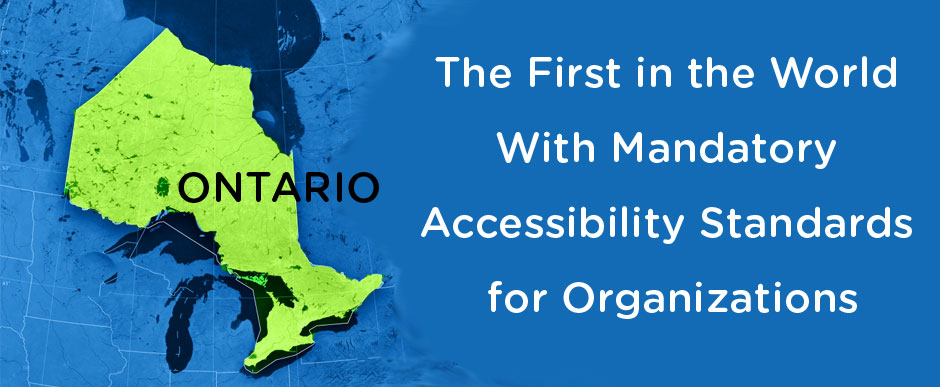ACCESSIBILITY LEGISLATION IN ONTARIO
The Accessibility for Ontarians with Disabilities Act, AODA, became law on June 13, 2005. Ontario is thus the first province in Canada to pass legislation to develop mandatory accessibility standards. The act aims to identify, remove, and prevent barriers for people with disabilities, in key areas of daily living. The goal is to make Ontario accessible to people with disabilities by 2025.
WHO IS AFFECTED AND WHEN
The AODA Accessibility Standards for Customer Service (Ontario Regulation 429/07) became law on January 1, 2008. The Ontario government and other designated public sector organizations were required to comply by January 1, 2010.
The Accessibility Standards for Customer Service also apply to private and non-profit sector employers that have at least one employee in Ontario, and that provide goods or services to members of the public or other organizations. Private and non-profit sector organizations were required to comply by January 1, 2012 and those with 20 or more employees were required to file a written report with the Accessibility Directorate of Ontario by that date.
The Province worked with representatives from the disability community, as well as public and private sector organizations, to develop the five accessibility standards described below.
THE FIVE AODA ACCESSIBILITY STANDARDS
First Regulation: Ontario Regulation 429/07
1) Accessibility Standards for Customer Service. Compliance was mandatory by January 1st, 2012. This standard addresses business policy, practices, and procedures and stipulates employee training needed to provide better customer service to people with disabilities. It is not about making structural changes; instead it focuses on attitudes and systems that create barriers to accessibility.
Second Regulation: Ontario Regulation 191/11
This regulation takes into account three Standards simultaneously and became a regulation in July 2011:
2) Accessible Information and Communications standards address the removal of barriers in access to information and include information being provided in person, through print, telephone, websites, and other means.
3) Employment Accessibility standards address paid employment practices relating to employee-employer relationships, including recruitment, hiring, and retention policies and practices.
4) Accessible Transportation standards, identified as crucial for people with disabilities, focus on aspects of daily life such as going to work, school or shopping. These standards address aspects of accessible public transportation including buses, trains, and taxis.
Third Regulation: Legislated in the fall of 2013
5) Design of Public Spaces Standard addresses access to and within buildings and outdoor spaces. These standards are harmonized with the Ontario Building Code, and cover issues such as counter height, aisle and door width, parking, and way-finding signage.
HOW ACCESSIBILITY BENEFITS BUSINESS
The Royal Bank of Canada estimates that people with disabilities have discretionary spending power of about $25 billion annually across Canada. Improving accessibility is not only the right thing to do; it’s also a good business strategy.
Disability impacts more than 15% of Ontario’s population or about 1.85 million people. That’s one in seven people already and the number is increasing as our population ages. Over the next 20 years the number will rise to one in five. Today, more than 40% of people over age 65 suffer from a disability.
More than half of the population has a friend or a loved-one with a disability, and is influenced by them when deciding which businesses to solicit.
In addition, people with disabilities also represent a large, relatively untapped source of skilled workers who could solve many of Ontario’s employer needs over the coming years. Hiring people with disabilities is proven to increase overall employee satisfaction and loyalty.
AODA DEFINITION OF PEOPLE WITH DISABILITIES
People with disabilities are often thought of as those in wheelchairs and with visible physical disabilities. Disabilities can also be non-visible. A wide range of disabilities includes vision, deafness or being hard of hearing, intellectual or developmental, learning, and mental health.
The Accessibility for Ontarians with Disabilities Act, 2005 (AODA) uses the same definition of “disability” as the Ontario Human Rights Code, which includes both visible and non-visible disabilities.
IMPLEMENTING THE STANDARDS
Organizations covered by the standard must file accessibility reports. Non-compliance with an order, filing false reports and other infractions may result in serious financial penalties. Click here to learn more on achieving compliance.


